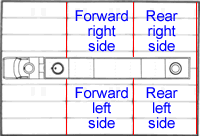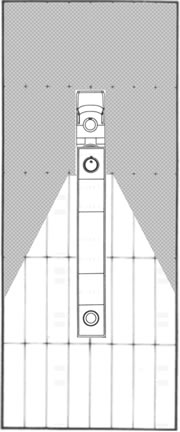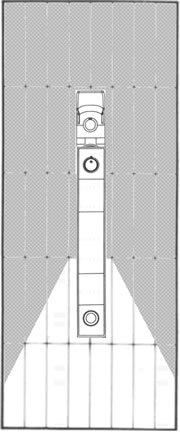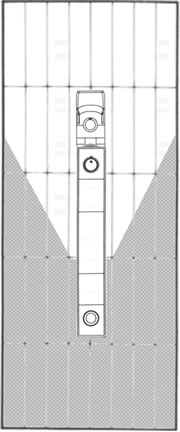 A tractor and rig have some unique abilities in combat and to be a successful trucker, you're going to have to know them. This section should keep you up to speed with truck capabilities.
A tractor and rig have some unique abilities in combat and to be a successful trucker, you're going to have to know them. This section should keep you up to speed with truck capabilities.
Unless noted, treat a cab exactly like a normal car, save that it uses a special target matrix.

The following are additional modifiers that should be used when shooting at tractors and rigs.
| Shooting a cab or trailer which is in one lane of a fire corridor | +1 |
| Shooting a cab or trailer which is in two lanes of a fire corridor | +2 |
| Shooting a cab or trailer from the side | +2 |
 Passive weapons work as normal on tractors and rigs. The only thing to note is that any passive weapons mounted on the tractor may not be used while a trailer is attached.
Well, lets put it another way. Passives can be used, but they will automatically effect the trailer. Which isn't a good idea.
Passive weapons work as normal on tractors and rigs. The only thing to note is that any passive weapons mounted on the tractor may not be used while a trailer is attached.
Well, lets put it another way. Passives can be used, but they will automatically effect the trailer. Which isn't a good idea.
 Passive weapons effect tractors and trailers as normal. Smoke will rise high enough to block turret weapons from a trailer.
Passive weapons effect tractors and trailers as normal. Smoke will rise high enough to block turret weapons from a trailer.
 Trailers are large vehicles, taking up two spaces on the road. Because of this, they are split into two sections, the forward and rear section. The differing sections of the trailer take up exactly half the trailer.
Trailers are large vehicles, taking up two spaces on the road. Because of this, they are split into two sections, the forward and rear section. The differing sections of the trailer take up exactly half the trailer.
Each section of a trailer has its own armour values (which can be different when constructing trailers in the advanced construction section) and its own collection of weapon mounts.

When a trailer is hit you'll need to work out which section is hit. This should be pretty easy to determine as each section is half the trailer, but if needs be and you can't figure out which part of the trailer is hit, roll a die. Evens score a hit on the front of the trailer, while odd results hit the rear part.
All hits inflicted on the trailer come from a single damage total, there is not a separate total for each section of the trailer.
Trailers do not take incremental damage like other vehicles, and thus do not reduce a rigs handling, acceleration or top speed when they take a certain amount of damage.
If the trailer receives a critical hit, these are rolled as normal, but only equipment on the section hit can be damaged.
For example, a tanker trailer with a forward turret and 2 passive mounts is hit on the rear section. If a weapon critical is hit, only the passive mounts can be damaged, not the turret.
The trailer target matrix chart will detail further effects.
Note that while attached to a tractor, a trailers front armour (not front section) cannot be hit by weapons fire. Any shots to the front armour will hit either the cab or the side armour.
 A trailer is buit for carrying cargo and thus has a large area for storing it. Whenever a shot damages the trailer, there will be some damage to the cargo itself. Every damage point inflicted on the cargo will destroy a percentage of cargo equalling the damage point percentage - for example a box trailer has 50 damage points, so every point of damage will destroy 2% of the cargo carried. Unless the cargo is particularly volatile or sensitive, then this damage will have no additional effects on the trailer or the game. After the battle however, cargo hits will have to be determined as to what really happened.
A trailer is buit for carrying cargo and thus has a large area for storing it. Whenever a shot damages the trailer, there will be some damage to the cargo itself. Every damage point inflicted on the cargo will destroy a percentage of cargo equalling the damage point percentage - for example a box trailer has 50 damage points, so every point of damage will destroy 2% of the cargo carried. Unless the cargo is particularly volatile or sensitive, then this damage will have no additional effects on the trailer or the game. After the battle however, cargo hits will have to be determined as to what really happened.
Critical hits on cargo though, will effect it much more greatly (see below).
This ruling is not applied to flatbed trailers - however, the cargo takes damage if the trailer is missed.
 Flatbed trailers are very thin trailers. They don't protect their cargo at all, and indeed, when shooting at a flatbed, there is a very real chance that the trailer won't even be hit. Use these special rules when attacking flatbeds. Unless stated, all normal rules for trailers (above) apply in addition.
Flatbed trailers are very thin trailers. They don't protect their cargo at all, and indeed, when shooting at a flatbed, there is a very real chance that the trailer won't even be hit. Use these special rules when attacking flatbeds. Unless stated, all normal rules for trailers (above) apply in addition.
When shooting at a flatbed trailer and hitting it, roll a die. On an even score, the trailer itself was not hit, but any cargo on it was. The cargo suffers the full effects of the hit and the trailer is unharmed. On an odd result, the trailer is hit and suffers full effects of the hit.
If a car is armed with a vertical swivel mount, or if the firer is another truck, then it may try and target the cargo on a flatbed trailer. A normal to-hit is made with a -1 modifier. If successful, then the cargo on the trailer is hit, else the shot misses.
A flatbed trailer has no roof facing. If a shot hits from above and strikes the trailer, use the floor armour facing. Any critical scored will also use the floor facing.
 When a trailer takes terminal damage, then the following happens.
When a trailer takes terminal damage, then the following happens.
All power to weapons cease. Lasers have one additional shot and then cease to function. Turrets and missile guidance systems will not work. Further hits ignore damage rolls, but can still score critical hits. Trailers won't explode unless they are carrying some kind of volatile cargo, like fuel.
If the front section of the trailer is hit, then make a trailer-break test.

A turret or roof mounted weapon on a tractor or trailer is at a much greater height than those mounted on cars, and this has an impact in combat. For the following notes, turret weapons also apply to roof mounted weapons.
Turrets mounted on a tractor may not fire at any ground targets within 1 space of the tractor. If a target is within 2 spaces of the tractor, then the gunner of the tractor turret has the option to fire at either the side or the roof of the target. Targets at a range of greater than 2 spaces may only have their sides targeted.
Turrets mounted on a trailer are even higher than those mounted on a trailer. As a result, any ground targets within 2 spaces of the trailer are not able to be targeted by the trailer. A target within 3 spaces of the trailer may have either its roof or its side attacked by the trailer, and targets at a range of greater than 3 spaces may only have their sides targeted.
If the target of a tractor or trailer is another tractor or trailer, then none of this applies. A fellow tractor or trailer may be targeted at any distance, and the roof of the vehicle may not be targeted.
Measure all spaces for turret heights with the range ruler.
A turret or roof mounted weapon from the tractor cannot fire through or across the trailer, however a front mounted trailer turret can fire over the cab. A front mounted turret on a trailer cannot fire across the rear of the trailer. A rear-mounted turret cannot fire across the front of the cab.
| Cab Turret Arc | Front Trailer Turret Arc | Rear Trailer Turret Arc |
|---|
 |
 |
 |
The shaded area is the turret arc of fire.
 Unless noted here, all critical hit results are exactly like those for cars.
Unless noted here, all critical hit results are exactly like those for cars.
 Cargo is damaged with most shots to the trailer without much in the way of additional damage, but a critical hit means that something major has been hit with more in the way of repercussion to the vehicle or the cargo. Obviously the exact results will vary depending on what cargo is actually carried. Here are some ideas:
Cargo is damaged with most shots to the trailer without much in the way of additional damage, but a critical hit means that something major has been hit with more in the way of repercussion to the vehicle or the cargo. Obviously the exact results will vary depending on what cargo is actually carried. Here are some ideas:
Empty trailers: An empty trailer has nothing to take damage and thus the critical hit has no further effect.
Fuel: A tanker filled with fuel is highly explosive. The cargo is treated as a Fuel Critical Hit, but if the fuel explodes, then the entire trailer explodes and is destroyed. Everything within a two space radius of the centre of the exploding trailer (including the rear of the cab) takes a +8HE hit and must make a hazard check at a safety limit of 40 mph.
Vehicles: A carried vehicle will take a normal hit at the damage value of the weapon minus the armour value of the trailer. In addition, roll a die. On a 6, the carried vehicle also takes a critical hit.
 Tractors are designed to be able to carry more than one person, and frequently they are seen with internal gunners, cupola gunners and passengers. As such, the Crew critical denotes a hit on one of the personnel in the vehicle. All crew members in the cab have an equal chance of being hit.
Tractors are designed to be able to carry more than one person, and frequently they are seen with internal gunners, cupola gunners and passengers. As such, the Crew critical denotes a hit on one of the personnel in the vehicle. All crew members in the cab have an equal chance of being hit.
Use the following chart to denote who gets hit. The table lists one driver and one gunner and two passengers. If there are additional gunners, denote which passenger is a gunner for the attack.
| Die Roll | Two Seater | Three Person | Four Man |
|---|
| 1 | Driver | Driver | Driver |
| 2 | Driver | Driver | Gunner |
| 3 | Driver | Gunner | Passenger 1 |
| 4 | Gunner | Gunner | Passenger 2 |
| 5 | Gunner | Passenger | Roll Again |
| 6 | Gunner | Passenger | Roll Again |
cupola gunners can still get hit when their weapon recieves damage, as normal.
 The fifth wheel, the bolt connecting the trailer to the tractor, has been hit. Make a trailer-break test.
The fifth wheel, the bolt connecting the trailer to the tractor, has been hit. Make a trailer-break test.
 The connections linking the tractors braking and driving systems with the trailer have been hit. Reduce braking and acceleration by half, and handling by 1. These penalties are lost when the trailer is seperated from the tractor.
The connections linking the tractors braking and driving systems with the trailer have been hit. Reduce braking and acceleration by half, and handling by 1. These penalties are lost when the trailer is seperated from the tractor.
 The couplings supplying power from the tractor to the trailer to energise weapons (such as lasers) have been hit. Laser weapons on the trailer have one additional shot and then they cannot fire again. In addition, turrets and missile guidance systems no longer function.
The couplings supplying power from the tractor to the trailer to energise weapons (such as lasers) have been hit. Laser weapons on the trailer have one additional shot and then they cannot fire again. In addition, turrets and missile guidance systems no longer function.
 The connections linking the tractors weapon systems with the trailers have been severed. As a result, no weapons on the trailer may be used again until this is fixed. The exception to this are cupola weapons which may still be used by their cupola gunners. No computers mounted in the cab may be used with trailer weapons, although cupola gunners may still receive benefits for a computer mounted on their turret.
The connections linking the tractors weapon systems with the trailers have been severed. As a result, no weapons on the trailer may be used again until this is fixed. The exception to this are cupola weapons which may still be used by their cupola gunners. No computers mounted in the cab may be used with trailer weapons, although cupola gunners may still receive benefits for a computer mounted on their turret.
 Weapon criticals are as normal, but cupola gunners can only be hit on trailers when their weapon is hit. When this happens, roll a die. On an even score, the gunner is hit. On an odd result, the weapon is hit.
Weapon criticals are as normal, but cupola gunners can only be hit on trailers when their weapon is hit. When this happens, roll a die. On an even score, the gunner is hit. On an odd result, the weapon is hit.
 Wheel criticals are handled as normal, but all truck and trailer wheels are treated as being reinforced as standard. This accounts for their greater size, weight and density of wheels.
Wheel criticals are handled as normal, but all truck and trailer wheels are treated as being reinforced as standard. This accounts for their greater size, weight and density of wheels.
 Trailer wheels are tied into a cabs systems, and their destruction and loss will effect a cab while the trailer is attached.
Trailer wheels are tied into a cabs systems, and their destruction and loss will effect a cab while the trailer is attached.
All effects are as the normal wheel critical table. All trailer wheels are treated as being Rear Wheels. All Handling reductions are 1 point, not 2.
Rear Wheels - Axle Hit: Acceleration is halved with these results, and a trailer is not wrecked.
Once a trailer has been dumped, then all handling and acceleration penalties due to the damaged trailer are lost.

